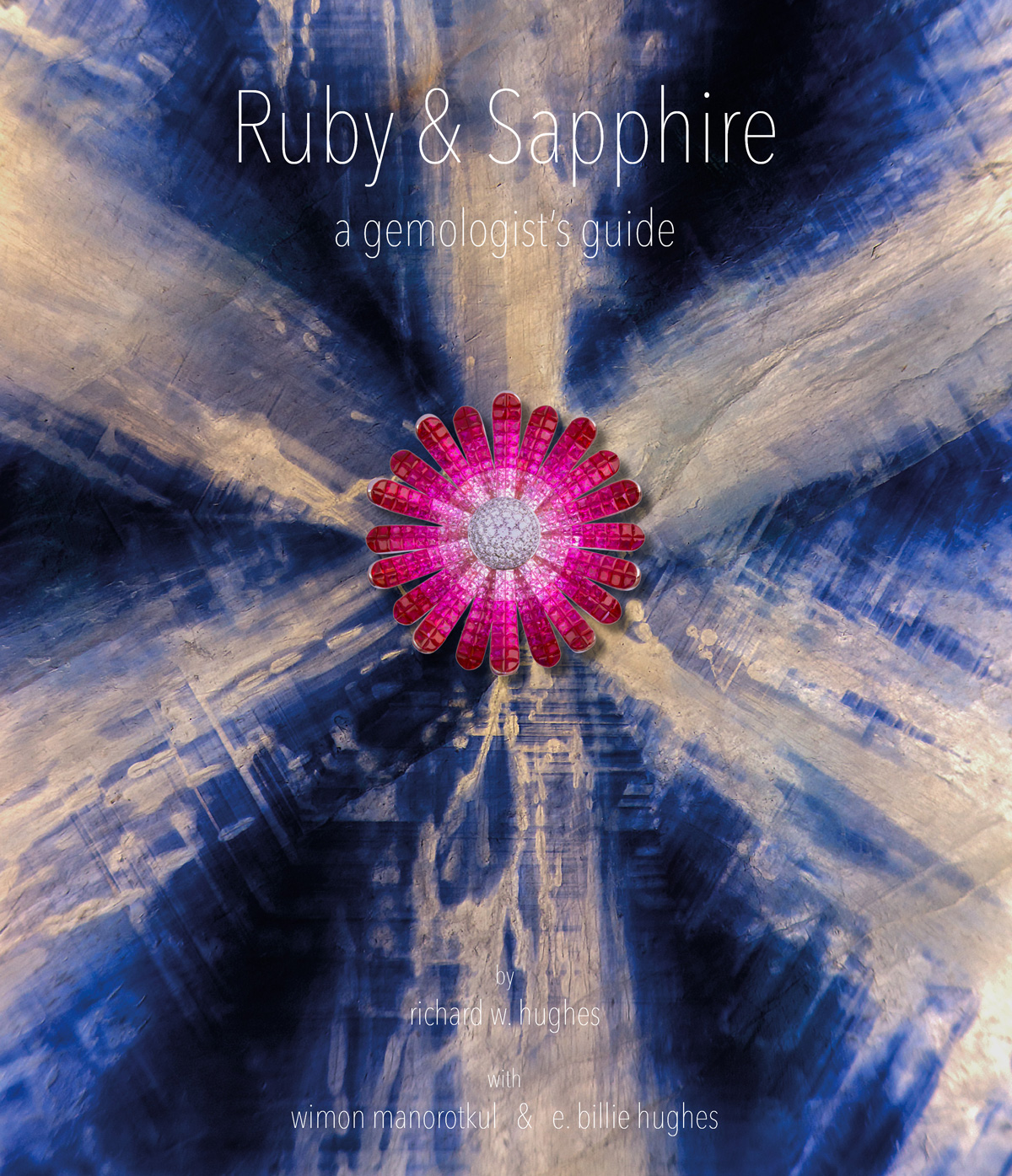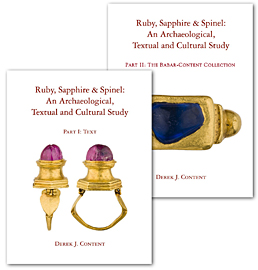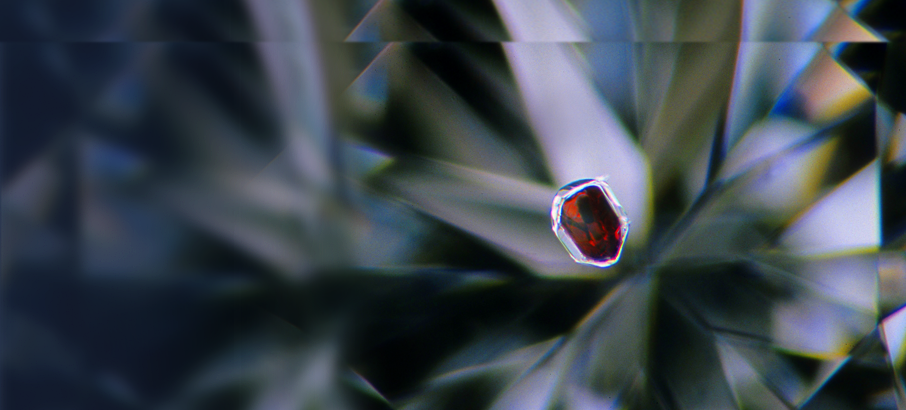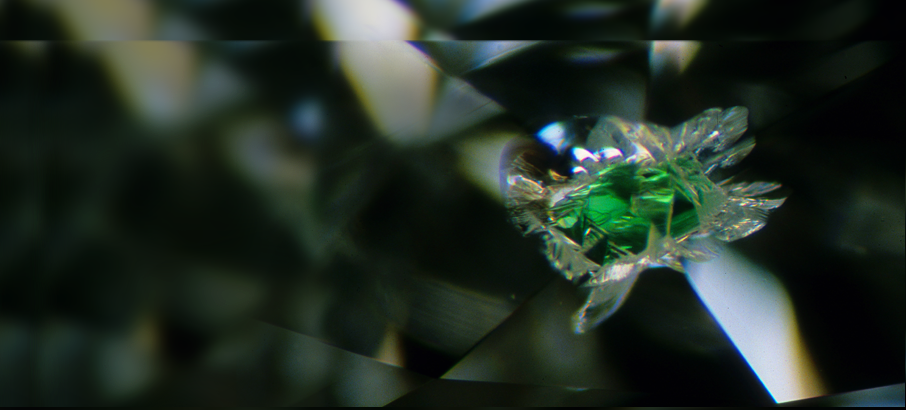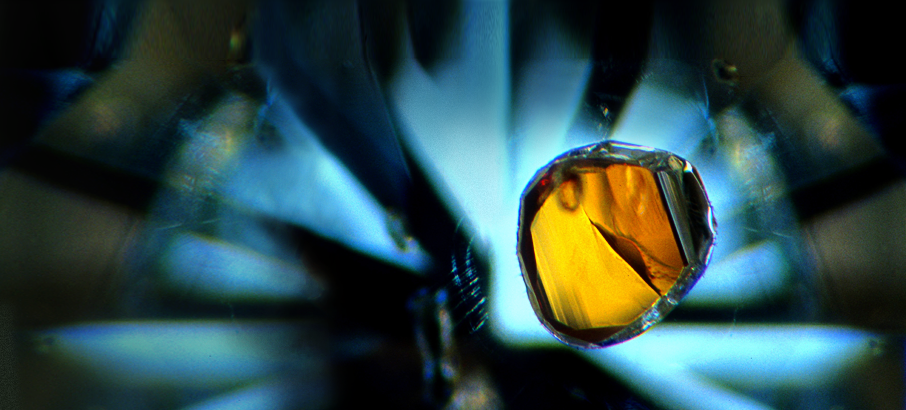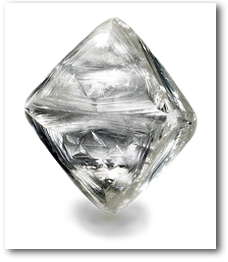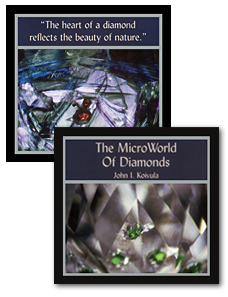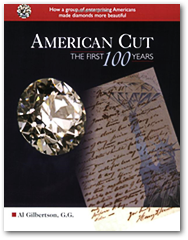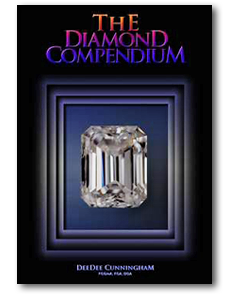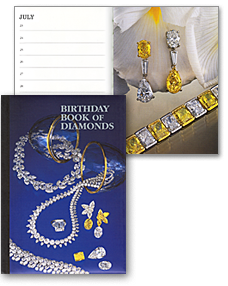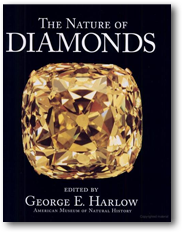NINTH ANNUAL SINKANKAS SYMPOSIUM – PRINTED PAPERS
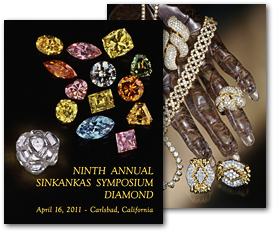
Cost: unit price + shipping (varies according to shipping options and destination)
Volume 1 only – USD 22.00 + shipping
Volume 2 only – USD 8.00 + shipping
Volumes 1 and 2 (set) – USD 25.00 + shipping (value pricing)
Specifications Volume 1: 8/5" x 11"; soft cover, 71p., 79 col. pl., 1 col. map, 1 B&W pl., 16 diag.
Specifications Volume 2: 8/5" x 11"; soft cover, 37p. B&W
Place an Order »
Photographs by Harold and Erica Van Pelt, Robert Weldon, John Koivula and Mia Dixon
Table of Contents – Volume 1
Acknowledgments iv
Speaker and Author Biographies v
Articles –
Al Gilbertson and Scott Sucher, The Evolution of Diamond Cutting 1
Dr. Skip Simmons, The Crystal Structure and Mineralogy of Diamond 19
Dr. James E. Shigley, Geology of Diamond Deposits 25
John Koivula, The Microworld of Diamond: Minerals and Clouds from the Earth's Mantle 33
Dr. Mike Breeding, Diamond Treatments and How Treatment Affects Color in Diamond 49
Dr. Sally Eaton-Magaña, Synthetic Diamond Production 59
Jo Ellen Cole, Fancy Cut Diamonds – Evolution and Valuation 65
Table of Contents – Volume 2
Acknowledgements iv
Speaker and Author Biographies v
Articles –
Si and Ann Frazier, Quartz as Diamond 1
Meg Berry, Diamonds are a Drill's Best Friend: or the Secret Life of Bort 19
Dr. James E. Shigley (compiled by), Articles on Diamond Geology and Diamond Deposits (2000–2010) 27
Registration for the one-day event includes morning and afternoon refreshments, lunch and a copy of the 2011 Sinkankas Symposium proceedings, which features selected papers on Diamond.
NINTH ANNUAL SINKANKAS SYMPOSIUM – DATE and VENUE
Saturday, April 16, 2011
GIA (Gemological Institute of America)
World Headquarters and The Robert Mouawad Campus
5345 Armada Drive
Carlsbad, CA 92008
NINTH ANNUAL SINKANKAS SYMPOSIUM – PROGRAM *
Recognized specialists in fields ranging from geology and mineralogy to history, treatment, cutting, collecting and selling will make presentations on Diamond.
Meg Berry – Uses of Diamond in the Lapidary Arts
Abstract needed (1–2 short paragraphs).
Dr. Mike Breeding – Diamond Treatments and How Treatment Affects Color in Diamond – abstract »
The rarity of natural colored diamonds and their associated high selling prices have resulted in widespread treatment of "off-color" stones to produce more appealing hues. Common diamond color treatments and recent advances in complex multi-step treatment processes will be presented. Structural changes associated with these color treatments will be discussed and contrasted against lattice defects in naturally colored diamonds.
Dr. Sally Eaton-Magaña – Synthetic Diamond Production – abstract »
Synthetic diamonds were first created more than 50 years ago and are now available as gemstones for jewelry. Synthetic diamonds are made by two very different processes: at high temperature and high pressure (HPHT) which mimic conditions that lead to natural diamond growth in the earth. The second method, chemical vapor deposition (CVD), allows synthetic diamond to grow at moderate temperatures and vacuum pressures as a thin film. These two methods will be discussed along with their gemological identification.
Al Gilbertson, GG – The Evolution of Diamond Cutting, Part II – abstract »
Early diamond cutting or polishing followed the shape of the original crystals and cutting styles evolved very slowly at first. As new technologies have been applied, cutting styles and methods have also evolved. This talk traces certain milestones and introduces some of the latest technologies being applied to commercial diamond cutting since the early 1800s.
John Koivula – The MicroWorld of Diamond – abstract »
A pictorial tour is presented on the microscopic features that make natural, untreated diamonds interesting—from superficial radiation stains and surface etching to internal features such as mineral inclusions and phantom structures.
Dr. George Rossman – Color in Natural Diamond – abstract »
Color in diamond is dominated by the way nitrogen, boron and assorted defects enter the diamond structure. Examples of various colors will be presented, as well as some insights into the atomic level origins of a few of the colors. In instances where we still do not understand the detailed origin of color, current thinking will be discussed.
Dr. James Shigley – Diamond Deposits – abstract »
Diamonds are not only of interest to jewelers and members of the public, but they are also of tremendous importance to geoscientists because they provide information on processes that occurred deep within the Earth in the distant geologic past. The geological processes responsible for the formation of diamonds, the unique information they provide to scientists, and the significant diamond-producing localities of the past decade will be described in this presentation.
Dr. Skip Simmons – Structure of Diamonds – abstract »
The common crystal habits of diamonds will be examined and diamond's crystal structure will be discussed in relation to cleavage, hardness and twinning.
Scott Sucher, keynote speaker – The Evolution of Diamond Cutting, Part I – abstract »
The history of the use of diamond and cutting techniques is described, beginning in the 1st millennium Bc through the early 19th century AD. Computer models of different diamonds cuts and their development are also discussed together with a presentation of some famous historical diamonds.
* speakers or topics subject to change without notice
NINTH ANNUAL SINKANKAS SYMPOSIUM – SPEAKER BIOGRAPHIES
Meg Berry – bio »
Meg Berry has been a lapidary artist working in the gem and jewelry industry since 1974. She studied gem cutting at Grieger's Inc. in Pasadena, where she was awarded a Master Faceter Certificate. She also studied gemology at the Gemological Institute of America (GIA) and received designations in Colored Stones and Gem Identification. Meg worked at Grieger's and also at a large Los Angeles wholesale gem house. Since From 1989 to 2003, she was a full-time cutter with Pala International, Inc., faceting myriad colored stones, as well as cabbing, carving, designing and stringing necklaces, and repairing and re-cutting damaged stones. Currently, she owns and operates a small lapidary called Megagem, where she works primarily for the trade and accepts commisions of custom cutting for private clients.
Meg has been recognized with more than a dozen trophies and awards at the annual American Gem Trade Associations' Cutting Edge competition, Tucson, Arizona, and has received international acclaim and contracts for her work. In 1992, the late treasure hunter, Mel Fisher, commissioned Meg to facet the largest of the rough emerald crystals recovered from the Spanish galleon "Atocha," which sank in 1622 in the Florida straits. Since then, Meg has cut more than one hundred of these "old mine" emerald crystals. During the construction of the GIA campus in Carlsbad, California, the late Vince Manson commissioned Meg to cut and polish the concept pieces of rocks and slabs placed as name plates outside each door.
Meg currently produces one-of-a-kind extraordinary gemstone creations using a combination of techniques that may include faceting, carving, frosting and piercing—sometimes all on the same stone! Her work is thematic, designed to elicit an emotional response and an appreciation for the beauty of Nature.
Dr. Mike Breeding – bio »
Dr. Christopher M. Breeding (Mike) joined GIA (Gemological Institute of America) as a research scientist in March 2004. He received his B.S. in Geology from the College of William and Mary in 1998, a Ph.D. in Geology from Yale University in 2004, and a G.G. from GIA in 2005. Prior to joining GIA, Dr. Breeding employed advanced geochemical analysis techniques to investigate fluid-mineral interactions at various scales and conditions within the earth. His current work at GIA focuses on the development of new identification methods for treatments that are used to enhance the color and clarity of diamonds and other gemstones.
Dr. Sally Eaton-Magaña – bio »
Sally Eaton-Magaña is a research scientist at the GIA Laboratory in Carlsbad. She holds bachelor's and master's degrees in chemical engineering from the University of Louisville, and a doctorate in the same field from Case Western Reserve University where she specialized in growth of sulfur-doped CVD synthetic diamond for engineering applications. For two years she worked as a post-doctoral researcher at the Naval Research Laboratory in Washington, D.C, studying methods to use functionalized CVD diamond films as sensors for chemical weapons. One project involved collaborating with the Smithsonian Institution to study the luminescence properties of the Hope Diamond, the Aurora Butterfly collection and other colored diamonds on permanent exhibit. That extraordinary opportunity introduced her to gem science. She chose to pursue gemology further, which naturally led to GIA. Her current research focus at GIA involves developing new methods to identify treatment in diamonds.
Al Gilbertson, GG – bio »
Al Gilbertson was raised in the lapidary business in Tehachapi, California, where his family operated a rock shop and jewelry store. After serving in the Air Force as a Russian Linguist, Gilbertson's custom gem-cutting for McDonald Jewelers in Fresno, California led him to become their manager, at the same time completing the coursework at GIA for a GG certification. Al and his wife later moved to Oregon, operating an appraisal service and a trade shop located on the premises of Zell Bros, in Portland, where they served specialty and high-end jewelers in the greater Pacific Northwest. Gilbertson continued providing custom-cut gems for jewelers in the area.
Gilbertson was a member of the American Gem Society's (AGS) Gemological Advisory Committee, setting up the AGS Laboratory in the mid-1990s. He then participated on AGS' Cut Task Force working towards a cut grading system for diamonds, and his patent was acquired by AGS as the foundation of its ASET technology for cut grading.
Gilbertson has lectured and furnished workshops for local and national jewelry and appraisal groups, and he has authored articles on appraising and diamond cut evaluation for national publications. GIA hired Gilbertson in 2000 to be a researcher for diamond cut evaluation, and he was a team member who helped to create GIA's cut grading system for the round brilliant. He is currently studying the influence of proportions and other factors on the appearance of fancy shape diamonds.
When Gilbertson joined GIA, he investigated previous research and concepts about supposedly "well-cut diamonds." As he delved into the history of gem cutting, he was surprised by what he learned, which led him to question much of his personal understanding about how the American Cut or Ideal Cut had evolved. His research expanded beyond the scope of the project and became a book, American Cut —The First 100 Years.
Al continues to enjoy custom cutting of colored gemstones.
John Koivula – bio »
John Koivula has spent over forty years studying and photographing the microworld of gemstones. He has published more than 800 articles and notes on gemstone inclusions and related topics, and he is a contributor to several books, including the American Geological Institute's Glossary of Geology, Robert Webster's Gems, and the GIA's Diamond Dictionary. Mr. Koivula is co-author with Dr. E. Gübelin of the Photoatlas of Inclusions in Gemstones, Volumes 1, 2 and 3, and author of The MicroWorld of Diamonds. Koivula holds university degrees in geology and chemistry, and the gemological credentials: G.G., C.G., F.G.A. He was awarded a fellowship in the Royal Microscopical Society, and also serves on the executive board of the International Gemmological Conference group (IGC). He is also an honorary life member of the Finnish Gemmological Society and the Gemmological Association of Great Britain, and was named one of the 64 most influential people of the 20th century in the jewelry industry by Jewelers' Circular Keystone Magazine. His awards include the Robert M. Shipley and Richard T. Liddicoat awards from the American Gem Society, the Scholarship Foundation Award from the American Federation of Mineralogical Societies, and the Antonio C. Bonanno Award for excellence in gemology from the international Accredited Gemologists Association. John Koivula is Chief Gemologist of GIA (Gemological Institute of America).
Dr. George Rossman – bio »
George R. Rossman is Professor of Mineralogy in the Division of Geological and Planetary Sciences, California Institute of Technology, Pasadena, California. His principal research interests deal with the use spectroscopic probes to study minerals. His work addresses problems relating to the origin of color phenomena in minerals; phase identification; optical effects in crystals; and the special role of metal ions in minerals. An important application of his studies is concerned with the role of low concentrations of water and hydroxide in nominally anhydrous solids. He and his students develop analytical methods for OH analysis and they examine the mode of incorporation of hydrous components in solids and their role in modifying physical and chemical properties. They also study X-ray amorphous minerals that include bioinorganic hard parts of organisms, products of terrestrial surface weathering, and radiation-damaged minerals. His interests include the long-term effects in minerals from the exposure to background levels of natural radiation.
Professor Rossman was the recipient of the inaugural Dana Medal of the Mineralogical Society of America in 2001, the Richard P. Feynman Prize for Excellence in Teaching at the California Institute of Technology in 2004, and the Friedrich-Becke Medal of the Austrian Mineralogical Society in 2005. He was also honored by having a new species of the tourmaline family named after him.
Professor Rossman joined the faculty at Caltech in 1971, where he has remained to this date. In 1966, he received a B.S. (Chemistry and Mathematics) from Wisconsin State University, Eau Claire, where he graduated Summa cum Laude. He holds a Ph.D. (Chemistry) from California Institute of Technology, Pasadena, 1971. Professor Rossman has been author or co-author of more than 260 publications in the mineralogical and chemical sciences.
Dr. James E. Shigley – bio »
After studying geology at the University of California (Berkeley) and later at Stanford University, Dr. Shigley joined the staff of GIA in 1982. For nearly thirty years, he has been part of a research group whose mission is to document new natural, synthetic and treated gem materials to determine how they can be identified by trained gemologists or by gem-testing laboratories. For two decades during that period, he was Director of Research for GIA.
Studies of the geology of gem deposits provide important information on ways that untreated natural gemstones can be recognized by gemologists. As part of the GIA research program, Dr. Shigley has visited diamond mines in Australia, Russia and in southern Africa. In the Spring 2001 issue of Gems & Gemology, GIA's quarterly professional journal, he and two co-authors wrote an article on the discovery and development of the Argyle Mine in remote northwestern Australia—the first major diamond mine in that country, and the world's leading source of diamonds by volume. In the special 10-year retrospective issues of the journal in 1990, 2000 and 2010, with the help of various individuals Dr. Shigley produced review articles of world gem localities, including lists of major diamond deposits, that were commercially important at the time.
Dr. Skip Simmons – bio »
Skip Simmons is Director of the MP2 Research Group at the University of New Orleans (MP2 stands for Mineralogy, Petrology and Pegmatology). He received his Ph.D. from the University of Michigan. He holds the honorary title of University Research Professor at the University of New Orleans, where he has taught in the geology department for 30 years. His principal specialty is the study of the mineralogy and petrology of pegmatites. He has published more than 200 papers in mineralogy and has been involved in the description of 22 new minerals and 5 discreditations. Simmonsite is named in his honor, in recognition of his work on granitic pegmatites and their mineralogy. Dr. Simmons is also a specialist in analytical mineralogy and supervises the mineralogical analytical facility in the Department of Geology, which houses the Electron Microprobe, Scanning Electron Microscope, X-ray Diffractometer and X-ray Cameras, Direct Coupled Plasma Spectrometer, and an X-ray Fluorescence Spectrometer. Research over the last four years with colleagues Karen Webber and Al Falster on modeling the cooling and crystal growth rates of highly evolved silicate magmas has changed the basic paradigm found in all geology text books that state, "big crystals are the result of slow cooling to allow time for crystals to grow to large size." In fact, Simmons and his team's models show that in some shallow level pegmatites the cooling rates are so fast that some of the world's largest crystals may actually grow in months to years, not millions of years. Several years ago, he and his colleagues published a new book on Pegmatology: Simmonsite Pegmatite Mineralogy, Petrology and Petrogenesis.
Scott Sucher – bio »
Scott Sucher is the principal of The Stonecutter in Tijeras, New Mexico. He is a retired Air Force instructor pilot with degrees in semiconductor manufacturing, chemistry and management. He first started cutting stones at the age of 14. After graduating from college in 1977, he started faceting replicas of famous diamonds in cubic zirconia. During his Air Force career, his extensive travels enabled him to visit many gem-producing localities, and although it precluded him from doing much cutting, he continued to give talks on various topics relating to the gem industry in many countries, including Japan, Thailand and Korea.
After he retired, Sucher resumed his research on historical diamonds. In late 2003, the Smithsonian Institution removed the Hope Diamond from its mount, and Sucher was engaged as a consultant to photograph it for computer modeling. The project was the subject of a Discovery Channel program, "Unsolved History: The Hope Diamond" (2005). Sucher went on to work with the Natural History Museum, London, and produced two plaster casts of the historic Koh-i-Noor diamond, which were laser scanned in Antwerp. He computer modeled the stone and co-authored an article about the project in the Summer 2008 issue of Gems & Gemology. In October 2007, he began collaborating with François Farges at the Muséum national d'Histoire Naturelle, Paris, on research into the French Blue Diamond. Together with other researchers over the next three years, he co-authored several papers on the French Blue, Tavernier Blue and Hope Diamonds. Sucher participated in a National Geographic program about the Hope and French Blue Diamonds, "Secrets of the Hope Diamond," which aired in December, 2010. Sucher's replicas of the historic and modern Koh-i-Noor diamond are on permanent exhibit at the Natural History Museum, London, and his replicas of the Hope, French Blue, and Tavernier Blue diamonds are on display at the Muséum national d’Histoire Naturelle, Paris. At the request of Smithsonian Institution, Sucher presented to the National Museum of Natural History his replicas of the Hope and Tavernier Blue Diamonds.
The American Museum of Natural History unveiled the Wittelsbach-Graff Diamond for public view on Thursday, October 28, 2011 in the Museum's Harry Frank Guggenheim Hall of Minerals. The Wittelsbach-Graff Diamond is an extraordinary 31.06-carat natural fancy deep blue diamond that was on display at the Museum through January 2011, courtesy of Laurence Graff.
Preview of "The Mystery of Hope Diamond," a Smithsonian Channel documentary.

